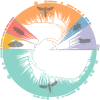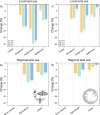A shortcut to sample coverage standardization in metabarcoding data provides new insights into land-use effects on insect diversity
- PMID: 40328305
- PMCID: PMC12055294
- DOI: 10.1098/rspb.2024.2927
A shortcut to sample coverage standardization in metabarcoding data provides new insights into land-use effects on insect diversity
Abstract
Identifying key drivers of insect diversity decline in the Anthropocene remains a major challenge in biodiversity research. Metabarcoding has rapidly gained popularity for species identification, yet the lack of abundance data complicates accurate diversity metrics like sample coverage-standardized species richness. Additionally, the vast number of taxa lacks a unified phylogeny or trait database. We introduce a new workflow for metabarcoding insect data that constructs a phylogenetic tree for most insect families, standardizes sample coverage and assesses both taxonomic and phylogenetic diversity along the Hill series. Applying this workflow to Central Europe, we analysed insect diversity from 400 families across a land-use gradient. Our results show that land-use intensity significantly affects sample coverage, highlighting the necessity of biodiversity standardization. Taxonomic diversity declined by 27-44% and phylogenetic diversity by 13-29% across 39 000 operational taxonomic units, with diversity decreasing from forests to agricultural areas. When focusing on rare species communities exhibited greater phylogenetic diversity loss than taxonomic diversity, whereas dominant species experienced smaller phylogenetic losses but more pronounced declines in taxonomic diversity. Our findings underscore the detrimental effects of agriculture on insect taxa and reveal a dramatic loss of phylogenetic diversity among rare species with potential consequences for ecosystem stability.
Keywords: Hill numbers; biodiversity; climate change; phylogenetic diversity; phylogenetic tree; taxonomic diversity.
Conflict of interest statement
We declare we have no competing interests.
Figures




Similar articles
-
Rarity is a more reliable indicator of land-use impacts on soil invertebrate communities than other diversity metrics.Elife. 2020 May 19;9:e52787. doi: 10.7554/eLife.52787. Elife. 2020. PMID: 32423527 Free PMC article.
-
Biodiversity assessments in the 21st century: the potential of insect traps to complement environmental samples for estimating eukaryotic and prokaryotic diversity using high-throughput DNA metabarcoding 1.Genome. 2019 Mar;62(3):147-159. doi: 10.1139/gen-2018-0096. Epub 2019 Jan 23. Genome. 2019. PMID: 30673361
-
Upscaling biodiversity monitoring: Metabarcoding estimates 31,846 insect species from Malaise traps across Germany.Mol Ecol Resour. 2025 Jan;25(1):e14023. doi: 10.1111/1755-0998.14023. Epub 2024 Oct 4. Mol Ecol Resour. 2025. PMID: 39364584 Free PMC article.
-
Performance of DNA metabarcoding, standard barcoding and morphological approaches in the identification of insect biodiversity.Mol Ecol Resour. 2024 Nov;24(8):e14018. doi: 10.1111/1755-0998.14018. Epub 2024 Sep 16. Mol Ecol Resour. 2024. PMID: 39285627
-
Towards holistic insect monitoring: species discovery, description, identification and traits for all insects.Philos Trans R Soc Lond B Biol Sci. 2024 Jun 24;379(1904):20230120. doi: 10.1098/rstb.2023.0120. Epub 2024 May 6. Philos Trans R Soc Lond B Biol Sci. 2024. PMID: 38705187 Free PMC article. Review.
References
-
- Felgentreff ES, Buchholz S, Straka TM. 2023. From science to society to practice? Public reactions to the insect crisis in Germany. People Nat. 5, 660–667. (10.1002/pan3.10434) - DOI
-
- Cardoso P, et al. . 2020. Scientists’ warning to humanity on insect extinctions. Biol. Conserv. 242, 108426. (10.1016/j.biocon.2020.108426) - DOI
-
- Saunders ME, Janes JK, O’Hanlon JC. 2020. Moving on from the insect apocalypse narrative: engaging with evidence-based insect conservation. BioScience 70, 80–89. (10.1093/biosci/biz143) - DOI
MeSH terms
Grants and funding
LinkOut - more resources
Full Text Sources

